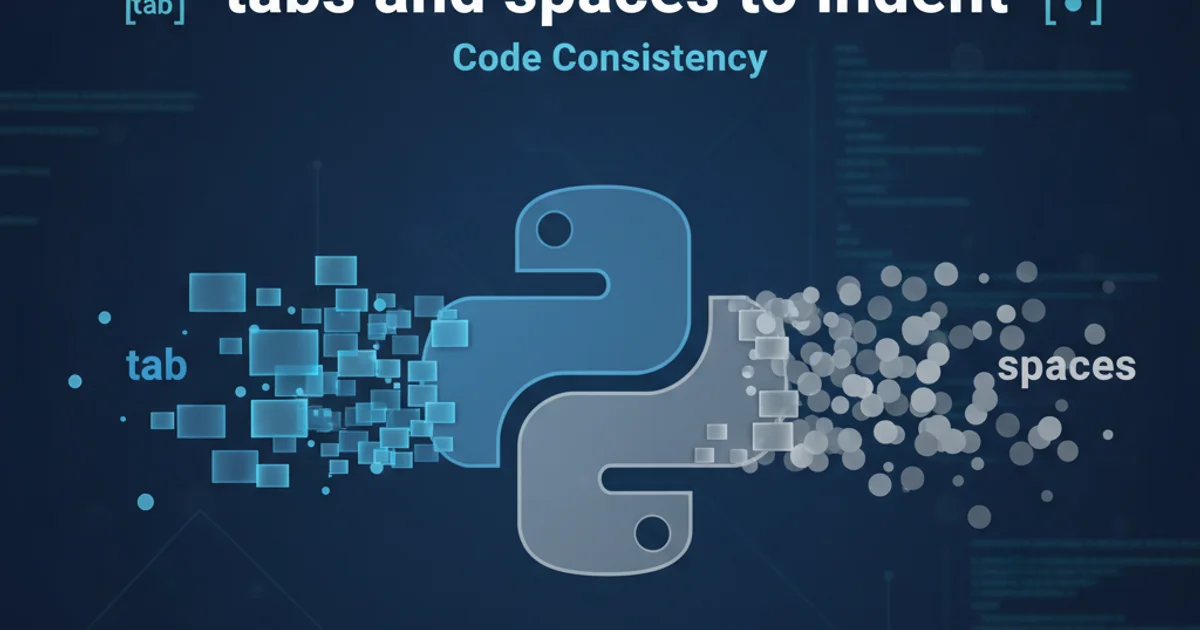Python's interpretation of tabs and spaces to indent
Categories:
Python's Indentation: The Tab vs. Space Debate and Its Implications

Explore how Python interprets tabs and spaces for indentation, the common pitfalls, and best practices to maintain consistent and error-free code.
Python is unique among many programming languages for using indentation to define code blocks, rather than relying on curly braces or keywords. This design choice makes Python code highly readable but also introduces a critical dependency on how indentation is handled. The perennial debate between using tabs and spaces for indentation is particularly relevant in Python, as inconsistencies can lead to IndentationError or TabError.
The Significance of Indentation in Python
In Python, indentation is not merely a stylistic choice; it's a fundamental part of the language's syntax. Code blocks, such as those following if statements, for loops, while loops, function definitions, and class definitions, are delineated by their indentation level. All statements within a block must be indented by the same amount. A change in indentation signifies the end of a block or the start of a nested block.
def my_function():
# This line is part of my_function
if True:
# This line is part of the if block
print("Hello")
# This line is still part of my_function
print("World")
# This line is outside my_function
Example of Python code structure defined by indentation.
Tabs vs. Spaces: The Core Conflict
The Python community, guided by PEP 8 (Python Enhancement Proposal 8), strongly recommends using 4 spaces per indentation level. While the Python interpreter can handle tabs, mixing tabs and spaces within the same file for indentation is a common source of errors. This is because different text editors and IDEs might interpret a tab character (\t) differently (e.g., 4 spaces, 8 spaces, etc.), leading to visual inconsistencies that hide actual indentation errors.
flowchart TD
A[Code Editor Input] --> B{Tab or Space?}
B -->|Tab| C[Tab Character (\t)]
B -->|Space| D[Space Characters ( )]
C --> E{"Editor's Tab Width Setting"}
E --> F[Visual Indentation (e.g., 4 or 8 spaces)]
D --> G[Visual Indentation (Fixed)]
F --> H{Python Interpreter}
G --> H
H --> I{Consistent Indentation?}
I -->|Yes| J[Code Executes Successfully]
I -->|No - Mixed Indentation| K[TabError or IndentationError]
I -->|No - Inconsistent Spacing| KFlowchart illustrating how tabs and spaces are processed and potential issues.
TabError and IndentationError.Common Indentation Errors and How to Resolve Them
Python's strict indentation rules mean that even a single misplaced character can halt execution. Understanding the common errors and how to fix them is crucial for any Python developer.
# Example of a TabError (if a tab is used where spaces are expected, or vice-versa)
def example_function():
print("This line uses a tab") # This might cause an error if other lines use spaces
print("This line uses spaces") # This line uses spaces
# Example of an IndentationError (inconsistent spacing)
def another_function():
print("First line")
print("Second line, incorrectly indented") # Too few spaces
# Corrected version:
def correct_function():
print("First line")
print("Second line, correctly indented")
Illustrating TabError and IndentationError scenarios.
Best Practices for Indentation
Adhering to best practices ensures your Python code is consistent, readable, and less prone to indentation-related errors.
1. Use 4 Spaces Consistently
Always use 4 spaces for each level of indentation. This is the official recommendation from PEP 8 and is widely adopted in the Python community.
2. Configure Your Editor
Set your text editor or IDE to automatically convert tab presses into 4 spaces. Most editors have this option in their settings.
3. Use Linters and Formatters
Integrate tools like flake8, pylint, or Black into your development workflow. These tools can automatically check for and fix indentation issues, ensuring code consistency across your projects.
4. Be Mindful When Copy-Pasting
When copying code from external sources, be aware that it might contain mixed indentation. Paste it into an editor that can automatically reformat it or manually check for inconsistencies.